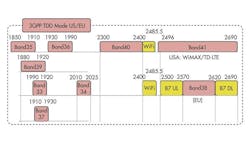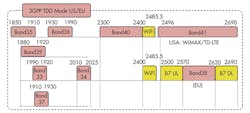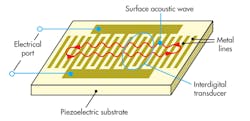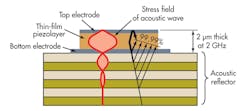LTE, WiFi, And WiGig Push Filter Capabilities
This file type includes high resolution graphics and schematics when applicable.
The frequency spectrum from 400 MHz to almost 6 GHz is full of a wide range of wireless and telecommunication allocations. LTE, GSM, CDMA, WiFi, Bluetooth, and many other standards occupy this range of complex frequency resources. To escape the congestion and increase data rates, frequencies around 60 GHz are being planned for close-range, high-speed wireless communications (known as WiGig). The issue of spectrum crowding is compounded when global spectrum usage is considered, as different countries use different spectrum allocations (Fig. 1).
Related Articles
• Filter Passes 902 to 928 MHz
• Upgrade Frequency-Selective Surface Filters From 2D To 3D
• Design for Strip-Line Band-Pass Filters
With modern electronics needing to either operate on all of these standards or isolate themselves from them, filter specifications are increasing in complexity. Electronic devices with wireless capabilities also are shrinking in size, requiring clever filter solutions to fit complex impedance networks in compact packages. Often, integration has become a necessity for filter manufacturers as they squeeze filters for nearly 60 wireless channels into a device that easily fits into the hand or pocket.
When asked about the impact of spectrum-density increases on filter design, Kevin Schoenrock, Director of Strategic Marketing & Advanced Development for TriQuint, responded, “New LTE bands with higher filter performance requirements are being squeezed next to existing bands within the crowded RF spectrum. With all the additional bands required for both antennas within a small phone-board area, filter design is now a key consideration and a decisive contributor to phone performance—along with wafer-level packaging for modular integration.” The latest technology in acoustic resonator filters is being put to the test to solve these space and precision constraints. Surface-acoustic-wave (SAW) and bulk-acoustic-wave (BAW) filters are today’s solution for RF and low microwave frequencies.
The advantages of acoustic-wave technology include a small footprint, shallow package size, enhanced linear phase, good rejection qualities, and stability over a wide temperature range. The physical structure of acoustic-wave devices also allows for highly reliable and robust designs that exhibit stability in a range of environments/temperatures. In addition, the wafer processing techniques used for these devices enable repeatable fabrication from high- to low-volume production.
The fundamental operation behind both SAW and BAW devices is a piezoelectric material, which converts an electromagnetic (EM) signal into an acoustic signal. This physical effect can be used to enhance the filtering response of a device beyond the capabilities of purely electronic devices for the form factor. Generally, SAW devices operate with good performance in the RF range, whereas BAW devices demonstrate higher performance characteristics in the low microwave range.
SAW filters consist of a piezoelectric substrate that is polished and capped at each end with a bi-directional acoustic-to-electric transducer. The body of the device is constructed of an array of interdigital electrodes with alternating polarities. This arrangement induces the generation of a surface wave when an EM signal voltage is applied across the electrodes (Fig. 2). A SAW filter is designed with specific characteristics by combining the impulse responses of the two transducers—derived from substrate etching of the two impulse responses. This approach differs from the fundamental operation of a BAW device.
A BAW filter uses a quartz crystal with metal electrodes on the top and bottom. When electrically excited, the quartz crystal produces acoustic waves that generate a standing acoustic wave within the device (Fig. 3). The acoustic energy is channeled vertically through the device. To achieve high frequency resonance, the bulk of the filter is micrometers thick. These structures are created using thin-film deposition techniques and a micromachined substrate.
Compared to other devices in their size category, BAW filters tend to achieve lower loss and higher Q factors at microwave frequencies. With Q values around 2500 to 2 GHz, the rejection ratio and insertion loss of such devices are very high. Such characteristics help to ensure sharp passband edges. Other variants of the BAW filter are the film bulk acoustic resonator (FBAR), which is fabricated by etching cavities to create suspended membranes with specific resonant qualities.
Avago, API, AMTI, Oscilent, and Trilithic all offer variants of acoustic-wave devices in a variety of packages and in common frequencies, which comply with the latest standards. Often, custom filter options are available from these companies for specific applications. To learn more about acoustic-wave filters, Schoenrock recommends Colin Campbell’s book, Surface Acoustic Wave Devices for Mobile and Wireless Communications, as well as RF Bulk Acoustic Wave Filters for Communications (edited by Ken-Ya Hashimoto).
This file type includes high resolution graphics and schematics when applicable.
The Way Forward
This file type includes high resolution graphics and schematics when applicable.
At this point, there are no design tomes and standard filter approaches for many emerging wireless applications. The new WiGig (IEEE 802.11ad) standard, for example, operates closer to millimeter-wave frequencies and requires a different set of filtering solutions. The goal of WiGig technology is to enable very-high-speed data transfer over short ranges in a compact and energy-efficient method. In literature, suggestions for WiGig filter solutions span substrate integrated waveguides, flip-chip bump resonators, micro-machined integrated-cavity approaches, and metal-foil-enhanced non-radiative dielectric waveguides.
Many R&D labs are researching a viable way to implement compact, efficient filters that can be easily integrated into modern IC processes. The propagation of EM radiation at 60 GHz is limited significantly by atmospheric and material absorption. In addition, WiGig can only operate to 10 m at low power levels. As a result, higher-power filters may not be necessary for WiGig applications. When selecting or designing filters for these complex and often coexisting frequencies, designers are offered many tools to help increase the efficiency of the filter block. Marten Seth, Marketing Director for WiSpry, emphasizes, “We encourage our customers to take advantage of circuit simulation tools, electrical models, and of course the OEM specifications.”
Many companies offer selection guides, modeling tools, and customer support to help designers select, design, or manufacture the most effective device for their application. Among them are TriQuint, WiSpry, API, AMTI, Avago, Oscilent, Reactel, and Trilithic.
Before designing a filter, many performance metrics must be considered. When asked about the key aspects to consider when approaching filter design, Schoenrock responded, “Electrical performance is evaluated based on insertion loss and selectivity, return loss, linearity, and power handling, while temperature stability in various operating conditions is another factor. For today’s thin and lightweight mobile devices, the z-height is just as important as the x-y footprint.” These factors—along with the type of filter—heavily influence the feasibility of certain technologies for a given design.
Some applications, such as military and aviation, have more stringent requirements for filter component specifications and reliability. Additional design complexity arises when considering a filter operating alongside many other filters to differentiate between the complex mesh of signals present in the modern wireless environment. New methods of solving these complex problems include filters with frequency characteristics that can be actively tuned to multiple frequency bands.
Tunable RF and microwave filters could enable a mobile device to operate with many different wireless standards in an on-demand typology. The root of this technology is the ability to change the fundamental filter component characteristics to alter the input/output characteristics of the filter block. This is often done by adjusting the capacitive values within an integrated environment using voltage control. Microelectromechanical-systems (MEMS) technology is frequently used to provide the highly precise control necessary to deliver accurate parameter adjustment.
Related Articles
• Filter Passes 902 to 928 MHz
• Upgrade Frequency-Selective Surface Filters From 2D To 3D
• Design for Strip-Line Band-Pass Filters
When asked about the challenges in modern filter design, WiSpry’s Seth notes, “There are numerous factors to consider including linearity, voltage, performance, etc. But the most challenging issue is often the wide-ranging requirements from OEMs to support growing bands and spectrum. This is why we believe tunable RF is the best path, dramatically reducing design time and board space.” In addition to WiSpry, firms like Cavendish Kinetics offer customizable and tunable RF-technology filtering options specifically for modern wireless standards.
With the constant influx of wireless technologies, meeting the filter requirements to isolate individual signals for telecommunications has become a more advanced design problem. Acoustic-wave technologies have shown promise by providing high-performance filtering characteristics to isolate signals in the highly competitive spectrum. As new wireless standards drive frequency-band densities to upwards of 60 distinct bands, however, fixed-filter solutions may not remain viable in enabling handheld wireless electronics. If tunable filter technologies can prove cost competitive and decrease the size requirements of filters, they may become common in the highly integrated RF ICs in modern devices.
This file type includes high resolution graphics and schematics when applicable.
About the Author
Jean-Jacques DeLisle
Jean-Jacques graduated from the Rochester Institute of Technology, where he completed his Master of Science in Electrical Engineering. In his studies, Jean-Jacques focused on Control Systems Design, Mixed-Signal IC Design, and RF Design. His research focus was in smart-sensor platform design for RF connector applications for the telecommunications industry. During his research, Jean-Jacques developed a passion for the field of RF/microwaves and expanded his knowledge by doing R&D for the telecommunications industry.




